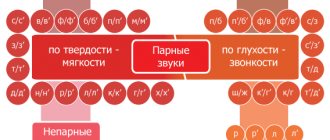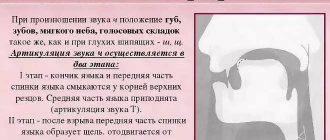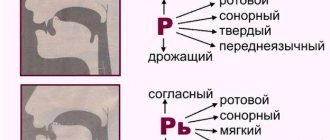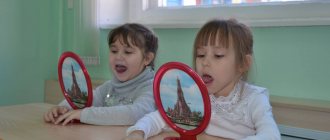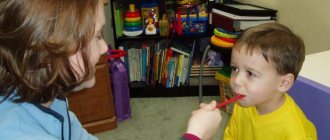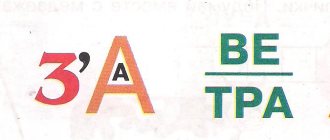The modern Russian alphabet consists of 33 letters, 10 of which are intended to represent vowel sounds and are accordingly called vowels. 21 consonant letters are used to represent consonant sounds. In addition, in modern Russian there are two letters that do not indicate any sounds : ъ (hard sign), ь (soft sign).
All sounds of the Russian language are divided into vowels and consonants.
- Vowel sounds are sounds that are formed with the participation of the voice. There are six of them in Russian: [a], [e], [i], [o], [u], [s] .
- Consonants are sounds that are formed with the participation of voice and noise or noise alone.
Features of consonants
a) Consonant sounds are divided into hard and soft . Most hard and soft consonants form hardness-softness pairs :
[b] - [b′], [c] - [v′], [d] - [g′], [d] - [d′], [z] - [z′], [j] - [ k′], [l] - [l′], [m] - [m′], [n] - [n′], [p] - [p′], [p] - [p′], [ s] - [s′], [t] - [t′], [f] - [f′], [x] - [x′]
(the apostrophe at the top right indicates the softness of the consonant). For example, bow - [bow] and hatch - [l′uk] .
b) Some consonant sounds do not have correlative pairs of hardness-softness, that is, in the language there are unpaired hard consonants [zh], [sh], [ts] (always only hard) and unpaired soft consonants [sh′], [th] , [h] (always only soft ones).
Notes:
- for sounds [й], [ч] it is not customary to indicate softness with an apostrophe, although in some textbooks it is indicated;
- the sound [ш′] is denoted in writing by the letter Ш;
- a line above a sound indicates a doubled (long) sound . In some textbooks, long consonants as follows: [van:a] - bath.
c) Consonant sounds formed with the participation of voice and noise are called voiced (for example, [d], [d′], [z], [z′], etc.); if only noise is involved in the formation of sounds, then such sounds are called voiceless consonants (for example, [t], [t′], [s], [s′], etc.). Most voiced and voiceless consonants in the Russian language form pairs based on voicedness and voicelessness :
[b] - [p], [b′] - [p′], [c] - [f], [v′] - [f′], [g] - [k], [g′] - [ k′], [d] — [t], [d′] — [t′], [z] — [s], [z′] — [s′], [g] — [w] . Compare: beat - drink, year - cat, live - sew.
d) The sounds [th], [l], [l′], [m], |m′], [n], [n′], [р], [р′] do not form a correlative pair with voiceless consonants, therefore, they are unpaired voiced (unpaired voiced consonants are also called sonorant , these are sounds in the formation of which both voice and noise are involved). Conversely, voiceless consonants that do not form a pair with voiced ones are unpaired voiceless . These are the sounds [h], [ts], [x], [x′] .
In a stream of speech, the sound of one sound can be likened to the sound of another sound. This phenomenon is called assimilation . So, in the word life, the sound [z], standing next to the soft [n′], also softens, and we get the sound [z′].
Thus, the pronunciation of the word life is written as follows: [zhyz′n′]. Sound convergence is also possible for sounds that are paired in terms of sonority and deafness. Thus, voiced consonants in positions in front of deaf ones and at the end of a word are similar in sound to paired deaf ones.
Consequently, deafening . For example, a boat is a lo[t]ka, a fairy tale is a jump[s]ka, a cart is a vo[s]. The opposite phenomenon is also possible, when voiceless consonants in a position before voiced ones also become voiced, that is, they become voiced . For example, mowing is ko[z′]ba, request is pro[z′]ba.
System of designations for various characteristics of sounds
Shibanova M.P. Teacher speech therapist
A system of notation for various characteristics of speech sounds as a means of forming phonemic processes.
Having observed the dynamics of children's speech development for a number of years, I noticed that the correction of phonemic processes occurs the slowest. Meanwhile, a sufficient level of formation of phonemic processes is the main condition for learning to read and write.
System of notation for various characteristics of speech sounds
After analyzing the specialized literature and the experience of my colleagues, I realized that there is no single system for designating the various characteristics of speech sounds.
So, L.N. Efimenkova suggests using any two different colors to differentiate sounds. Children, therefore, do not form a stable idea of whether a sound belongs to one group or another.
Of course, there are generally accepted designations for some characteristics of sounds, such as: red - a vowel sound, blue - a hard consonant, green - a soft consonant. The author of the book “Speech Flower” G. Vanyukhina suggests denoting the sonority of a sound with the image of a bell, vowel sounds with the image of open lips, and consonants with closed lips. These notations are cumbersome and inconvenient. Therefore, I developed my own notation system, which seems to me simple, concrete and logical, and also does not contradict generally accepted notations.
I decided to keep the red color to denote vowel sounds, but I think it is appropriate to use it to denote voiced consonant sounds, since the red color is associated with sonority - a quality inherent in both vowels and voiced consonants. I also think it is logical to designate vowel sounds with a circle, since they appear smooth, smooth, rounded, and consonants - with a square. For me, deafness is associated with silence, whispering, darkness, so I propose to designate deaf consonants with a black square. We will traditionally denote hard and soft consonants with blue and green colors, adding only a square shape. For consonants mixed according to articulatory characteristics, I chose yellow and brown colors, distributing them randomly between the sounds.
Material for drawing up diagrams of words and sentences, taking into account the notation system for various characteristics of speech sounds
I like the idea of L.N. Efimenkova to designate syllables in a word with separate short lines (- - -), and not with one line separated by strokes, as was previously customary.
With this method of notation, the child has the opportunity to pronounce a syllable and feel the syllabic composition of the word not only auditorily, but also kinesthetically. In addition, with this method, errors are less likely when recording the number of syllables - it can be difficult for children to understand that to denote a three-syllable word, only two strokes are needed to cross out the main line, and not three. In addition, such designations make it possible to draw up diagrams of words from handouts without drawing them in a notebook, which significantly saves time in speech therapy classes.
L.N. Efimenkova recommends using such schemes only to determine the number of syllables in a word. I consider it advisable to use them to differentiate consonant sounds.
First, the child determines the number of syllables in a word and lays out the corresponding number of strips. Then, pronouncing each syllable separately, determines whether there are differentiable sounds in it, their number, selects squares of the corresponding colors and places them above the syllables. Then, looking at the diagram, he writes the word in a notebook and underlines the letters denoting the differentiated sounds with the same colors. (Fig.1)
far ar foro in aya _
Fig.1
lentils _ _ _ _ _
To compile sentence diagrams, I developed the following material, using already existing notations and adding my own to them. (Fig.2)
a word with one voiceless consonant from a differentiable pair
a word with one voiced consonant from a differentiable pair
Fig.2
After children have made diagrams of the words with differentiable sounds included in the sentence, they can make a diagram of the sentence, and then write down the sentence and highlight the letters representing the differentiable sounds with the appropriate colors. (Fig.3)
Trezor was running behind
her from the tank .
_ He whines the knives . _ _
Fig.3
Didactic tasks for differentiating mixed speech sounds taking into account the notation system.
Sound mosaic
I really like the author’s game “Sound Mosaic” by speech therapist Olga Viktorovna Pilyugina, but I think its drawback is that the color designation of the sound is selected by the first letter in the color name. Thus, a stable idea of whether a sound belongs to one group or another is not formed. I used a system of notation for various characteristics of speech sounds for this game.
Each child has a card, which is a square divided into nine parts and a set of squares of red and black (yellow and brown) colors (Fig. 4).
Fig.4
The speech therapist pronounces sounds, syllables or words with differentiated sounds, the children lay out squares on a card of the appropriate color. The resulting pattern is compared with the sample (Fig. 5).
Fig.5
Syllable tables (Fig. 7).
Exercise.
Read the syllables, replacing the red square with the sound [b], the black square with the sound [p]. a and u
o e a
y and o
Exercise.
Read the syllables, replacing the yellow square with the sound [z], the brown square with the sound [z]. a and u
o e a
y and o
Fig.7
When compiling tables, it is necessary to remember that the letters Ш, Ж, Ш, Ш, Ц are not combined with all vowels. Therefore, if the tables are universal, they should not contain the letters Y, Z, Y.
Cards with words, sentences, texts.
At the first stage, cards are used in which the letters denoting the consonants being differentiated are replaced by colored squares.
Write it down, replacing the squares with the letters g , k.
ora ama lu a ut a olos
ios e s a ula rosa alstu
al a no a soba a du a udo
Fig.8
Write it down, replacing the squares with the letters
s , w .
om a ki iphone mind barely t
but ok kala ko a ol u triy
ito ka a irota taru ka krya
Fig.9
Write it down, replacing the squares with the letters
d , t.
There is a tree under the tree. Today is a good day. At the end of a sentence
need to score a point. Mom led the little glasses by the hand. On the lake
The gray one was swimming near the point. The fisherman needs a good one at the point. Wind
from the street the last leaves. Move the guest from the street.
Fig.10
Write it down, replacing the squares with the letters
h , shch .
Magpie.
Magpie loves glitter. Everything glitters, magpie, etc.
to yourself. One day a magpie stole a silver spoon. Malik saw
That’s what he shouted. The magpie got scared and released the spoon.
Fig.11
At the second stage, children write dictations using appropriate colors to write differentiated consonants.
Zhenya and Misha found a hedgehog in the garden .
S initsa is a
beautiful bird
.
_ _ Fig.12
Results of using a notation system for various characteristics of speech sounds
These types of tasks mobilize children's attention, increase interest in activities, and make it easier for them to differentiate sounds.
Thanks to the introduction of a new system of notation for speech sounds, children learn to more deeply feel and understand the difference between them. In their minds, stable ideas about the belonging of a sound to a particular group are fixed, which leads to the correct choice of letters denoting sounds and, as a result, competent writing.
At the same time, the new designations do not contradict the generally accepted ones, which ensures continuity in the work of a primary school teacher and a speech therapist.
The simplicity and logic of the new designations for the characteristics of sounds make them easy for children to memorize. These designations also expand the possibilities of creating new interesting tasks for the development of phonemic processes.
The use of new material for drawing up diagrams of words and sentences, taking into account the notation system for various characteristics of sounds, helps the child clearly imagine the syllable - the sound composition of a word, as well as the composition of a sentence when writing them by ear and control the correctness of spelling directly during the task and immediately after.
So, by drawing up a diagram of a sentence, and then writing it down and underlining the letters denoting the sounds being differentiated, the child will be able to compare the number and order of lines of certain colors with the number and order of colored squares in the scheme.
Improved self-control leads to a reduction in the number of errors in written work.
The use of sound mosaics and syllabic tables helps to firmly fix in the child’s mind the correspondence of color and shape to a certain sound, helps the development of phonemic hearing and phonemic perception.
Exercises in which letters are replaced by colored squares make it easier at first to differentiate consonants that are similar in acoustic or articulatory characteristics and help to concentrate the child’s attention when performing a task, increasing interest in classes.
Using colored pencils when writing dictations also leads to mobilizing children's attention and reducing the number of mistakes.
And all of the above factors lead to the achievement of the main goal - accelerating the development of phonemic processes and children more quickly mastering literate writing.
Literature.
Vanyukhina G.A. Rechtsvetik. Ekaterinburg: Starso, 1993.
Efimenkova L.N. Correction of oral and written speech of primary school students: Book. for speech therapists. M.: Education, 1991.
Efimenkova L.N., Misarenko G.G. Organization and methods of correctional work of a speech therapist at a school speech center. M.: Education, 1991.
Shapiro I.N., Kondakova M.F., Podshivalova M.IyuYu Ermonik Ts.G. Dictations and other materials for differentiating mixed letters. M.: Education, 1964.
6
Indication of softness of consonants in writing
In Russian, the softness of consonants is indicated in the following ways:
- Using the letter ь (soft sign) at the end of a word and in the middle between consonants: benefit - [pol′za], elk - [los′], etc.
Note. The soft sign does not indicate softness of consonants in the following cases:
a) if it serves to separate consonants, the second of which is y (yot): leaves - fox[t′ya], linen - be[l′yo];
b) to distinguish grammatical categories: rye (3 cl., f.r.) - knife (2 cl., m.r.);
c) to distinguish the forms of words (after hissing ones): read (2 liters, singular), cut (imperative form), help (indefinite form of the verb), as well as adverbs: jump up, lay down.
- Through the letters i, e, e, yu, i, indicating the softness of the preceding consonant sound and conveying the vowel sounds [i], [e], [o], [u], [a]: forest - [l′es], honey - [m'ot], lil - [l'il], hatch - [l'uk], crumpled - [m'al].
- Using subsequent soft consonants: cog - [v′in′t′ik], plum - [s′l′iva].
On the topic: methodological developments, presentations and notes
Knowledge of sound profiles is a necessary condition in the work of a speech therapist teacher. In order to teach how to speak correctly and beautifully, first, you need to know the position of the organs of articulation. Profiles.
Classification of sounds of the Russian language.
Classification of sounds of the Russian language, taking into account the anatomical and physiological features of their formation. The articulatory apparatus (active organs) takes the main part in the formation of sounds.
The main part in the formation of sounds is the articulatory apparatus (the active organs of which are the tongue, lips, lower jaw, soft palate; the passive organs are the teeth, the upper jaw.
Source
Sound meaning of letters e, e, yu, i
- The letters e, e, yu, i can represent two sounds : [ye], [yo], [yu], [ya]. This happens in the following cases:
- at the beginning of a word: for example, spruce - [ye]l, hedgehog - [yo]zh, yula - [yu]la, pit - [ya]ma;
- after a vowel sound: washes - mo[ye]t, sings - po[yo]t, give - yes[y]t, bark - la[ya]t;
- after the dividing words ь,ъ: eat - eat [e]m, drink - drink [yot], pour - l[y]t, zealous - ry[ya]ny.
In addition, after the separating ь, two sounds will be denoted by the letter and : nightingales - nightingale[y].
- The letters e, e, yu, i indicate the softness of the preceding consonant in the position after consonants paired in hardness-softness: fur - [m′eh], carried - [n′os], hatch - [l′uk], crumpled - [m′al].
Memo:
- The sounds [th], [l], [m], [n], [r] are voiced (do not have a voiced-voiceless pair)
- The sounds [x], [ts], [ch], [sh′] are voiceless (do not have a voiced-voiceless pair)
- The sounds [zh], [sh], [ts] are always hard.
- The sounds [th], [h], [sh′] are always soft.
Full phonetic analysis of the word
Phonetic analysis plan:
- Spelling of a word.
- Dividing a word into syllables and stress location.
- Possibility of transfer.
- Phonetic transcription of the word.
- Characteristics of all sounds in order:
- consonant - voiced - voiceless (paired - unpaired), hard - soft (paired - unpaired), which letter is indicated;
- vowel: stressed – unstressed.
- Number of sounds and letters.
- Cases of discrepancy between sound and letter.
Sample parsing
- Buddies
- Syllables: pri-ya-te-li (4 syllables; stress falls on the 2nd syllable).
- Transfer: when-I-those-whether.
- [pr'ijat'l'i]
- p [p] – consonant, voiceless pair, hard pair. р [р'] – consonant, voiced unpaired, soft paired. and [and] – vowel, unstressed. i bracket [j] – consonant, voiced unpaired, soft unpaired. [á] – vowel, stressed. t [t'] – consonant, voiceless pair, soft pair. e [b] – vowel, unstressed. l [l'] – consonant, voiced unpaired, soft paired. and [and] – vowel, unstressed.
- 8 letters – 9 sounds.
- The letter i denotes two sounds – [já].
Thus, speech sounds differ from all other sounds in that they form words. Sound is the smallest basic unit of language, along with words, phrases and sentences. But, unlike them, sound has no semantic meaning.
It is thanks to sounds that we distinguish between the words that we hear and pronounce: house [house] and rum [rum] - the difference is in one sound. Sounds create the sound shell of words and thereby help to distinguish words from each other, i.e. perform a meaning-distinguishing function.
On the topic: methodological developments, presentations and notes
The lesson contains elements of critical thinking technology - creating a cluster when working with text. The lesson is an example of organizing a system-activity approach in education.
The lesson contains elements of critical thinking technology - creating a cluster when working with text. The lesson is an example of organizing a system-activity approach in education.
Section of 9th grade physics “Mechanical vibrations and waves.” Presentation for the lesson “Sound. Characteristics of sound."
Summary of a physics lesson in 9th grade on the topic “Sound. Characteristics of sound."
This presentation can be used to study the new topic “Sound”.
The open lesson plan can be used to study the new topic “Sound Vibrations”.
Source
